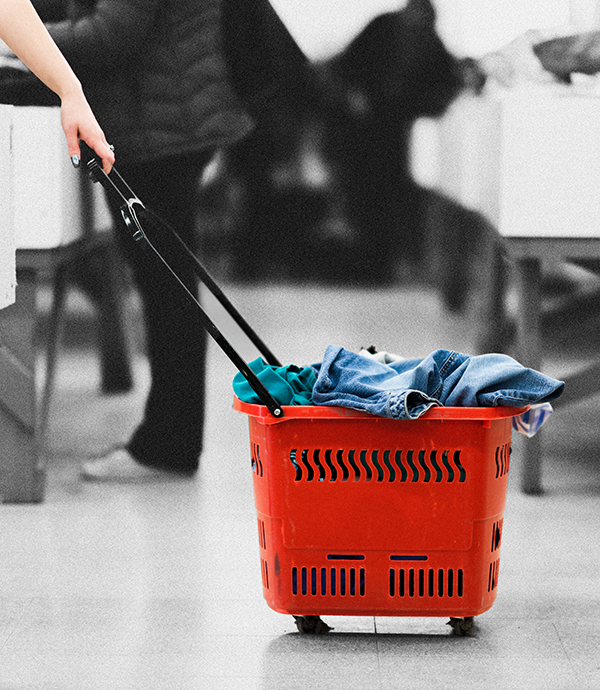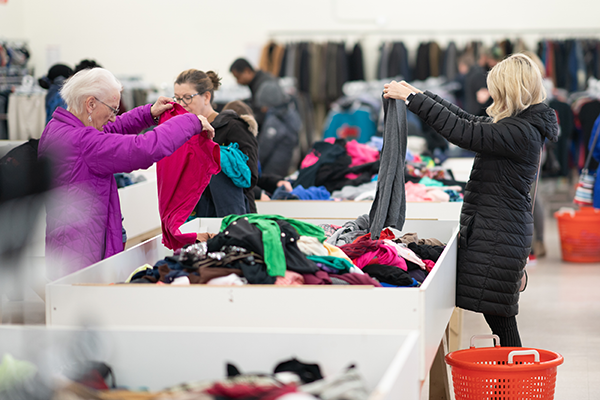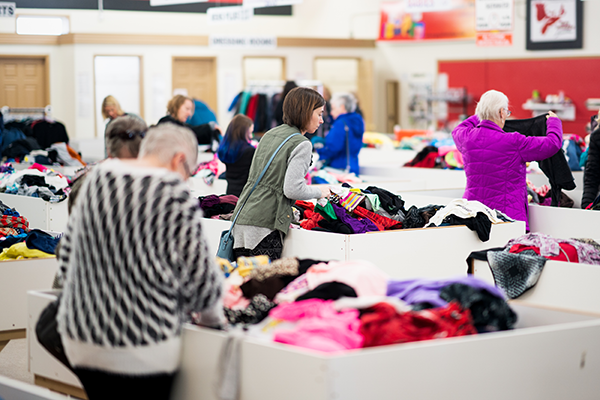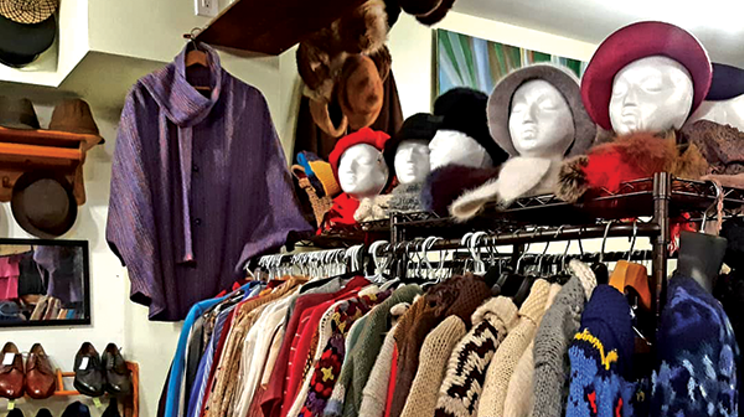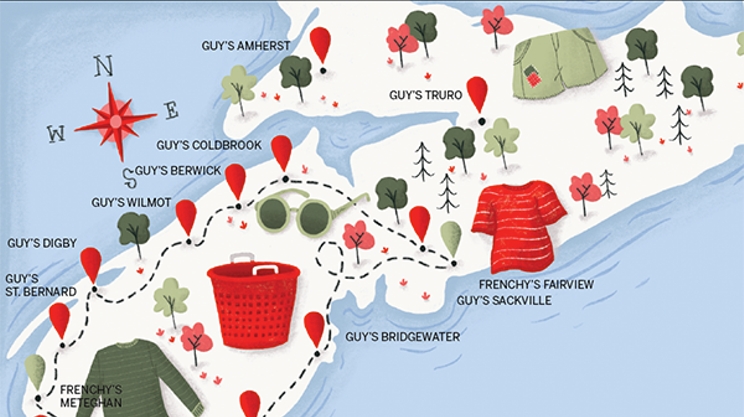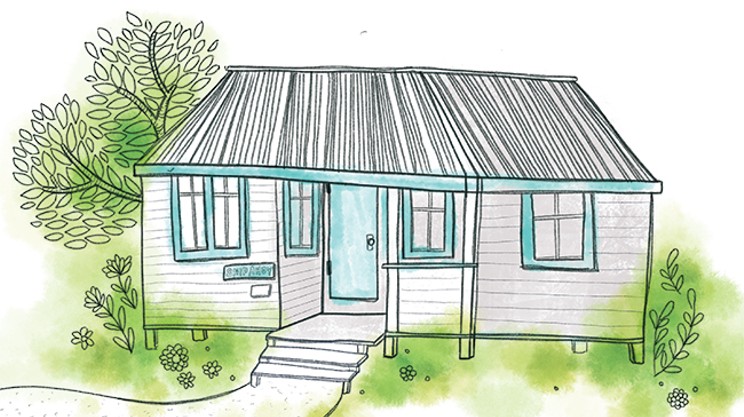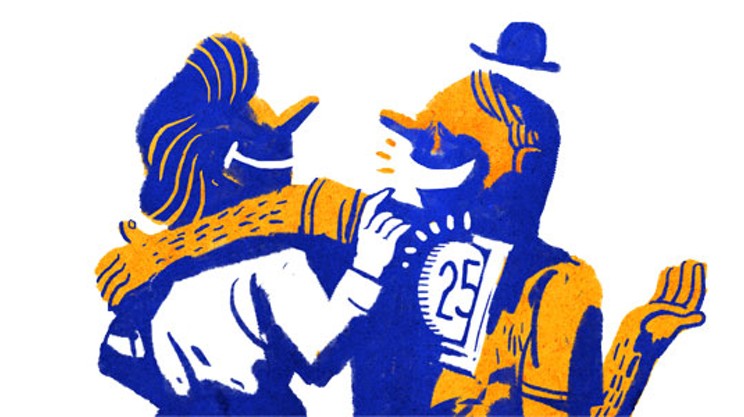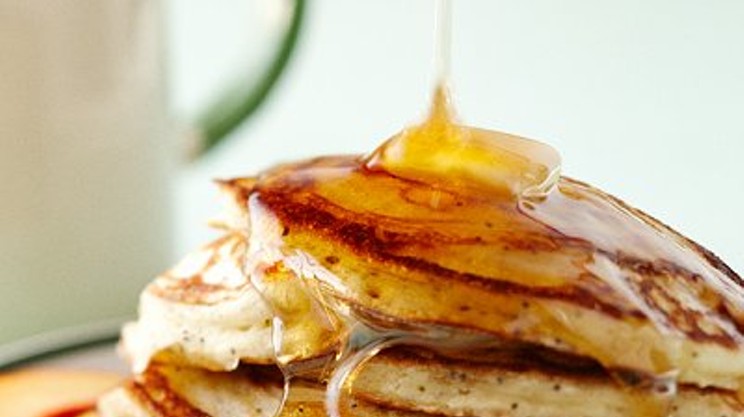Nicole Villeneuve had her fashion awakening in Guy's
How can a place where you can buy a pound of rags for 99 cents (or $18 for 20 pounds of the good, terry-cloth kind), a place where you can get jeans for $4.95, be an invisible link across lives? How can the network of second-hand stores that originated along the Acadian shore weave in and out of communities, generations and income lines as a surprising, beloved constant?
And how can a dramatic tale of divided business partners be hiding under all those clothes? Because while Frenchy's devotees happily share intelligence about best finds and favourite locations, nobody seems to know about the falling out in the corporate history, a split reminiscent of Ray Kroc and the McDonald brothers. It's a separation that explains the two distinct ways the stores are branded, Frenchy's and Guy's Frenchys—note the roving apostrophe—but that somehow seems too harsh for an industry that depends so heavily on used Boston sports team paraphernalia.
All of this was on my mind as the rental car slipped along the ribbon of
Every summer, Emily and Eleanor King's visits home to Nova Scotia are punctuated by Frenchys runs, a uniquely Nova Scotian term for piling into the car and visiting all
The full car tour, though, is bigger than a run. It's a marathon. A pilgrimage. An ad-hoc ritual many Nova Scotians take part in. The obvious stops are Guy's stores, well-marked on the map you can pick up at the counter of any given Guy's location. But, those looking for the full experience will pencil in some stops along the way at Frenchy's, the smaller, rainbow-lettered shops that live in the same link of the used clothing ecosystem as Guy's.
The full tour fills a solid weekend (maybe a long weekend if your pace sifting through the clothing bins isn't wrist-whipping-ly quick). It requires stamina, early mornings and the company of someone you trust: Rebecca Dimock tells me she only ever goes on Frenchy's tours with her best friend because they can spot finds for each other, give blunt feedback and make sure every bin they sift through has no gems left behind. A few Frenchy's fanatics say that dedicated tourers will often wear a swimsuit underneath their clothes for maximum fitting room efficiency.
Experience quickly taught me you should remember to check things over carefully for rips and stains, and you should keep a bottle of cold brew in the car because the coffee options can be bleak. (Save your hate mail, Bridgewater, and open your indie cafes on Sunday instead.) But, the rush of a find—say, an animal-print, gossamer-weight Ralph Lauren blouse in the bottom of a bin—can keep your energy high for hours, Tim Hortons be damned.
The route unfurls like a jagged smile around the bottom of the province, departing from Halifax after hitting the Guy's in Lower Sackville and stopping in Bridgewater, Liverpool and Shelburne along the south shore. The highway weaves back and forth from the coastline, each little town feeling more picturesque than the last. Amongst clapboard houses selling homemade pies and saltwater vistas complete with fishing boats, Halifax feels far behind me. I wonder if I've found the real Nova Scotia of books and of my imagination.
Most tourers overnight in Yarmouth, the natural halfway point, after stopping at the Guy's there—a small, grey shop that's nearly windowless, always busy and forever facing onto the depressing view of the Yarmouth airport (a landing strip in what looks like an old hay field).
Day two climbs the coastline of the Acadian shore, where the un-manicured views offer a textbook definition of rugged beauty. You'll stop in St. Bernard and Digby, and maybe you'll realize what a large swath of the province you're covering on the hunt for vintage Levi's. A constellation of Guy's in the Annapolis Valley caps the expedition, with Victorian mansion-filled main streets and apple orchards that look like pastoral paintings come to life.
The car darts inland, slicing along Highway 101, back to the Halifax you came from, closing the loop and the weekend. Diehards might take a detour to Truro or even Amherst for two more tastes of Guy's Frenchys before the sartorial feasting ends.
Jillian Cochrane says she takes the tour every June with her mom for her birthday. They experience Nova Scotia's irrepressible summer bloom on the drive, overnighting in a camper in windswept Clare, before returning with clothes for work and the gym and even baby clothes for friends. A recent grad with two degrees, these expeditions keep her wardrobe stocked. "I need to pay off my debt but still wanna look cute," she adds, the speakerphone crackling, as she—funnily enough—drives to the Guy's in Wilmot.
Though a handful of Guy's
With their stale air and utilitarian vibe, going to Guy's is the opposite of a quaint downtown shopping experience. It is not the sort of store where you idly pursue racks or soak in
Yet these stores with their squat shape and corrugated metal siding, shoulders braced against the Atlantic's rough winds, seem to say something about the places they're in.
The town of Berwick bills itself as the apple capital of the province. When I arrive at its Guy's, the fact that it shares a building with a Shur-Gain Feeds' N Needs farming supply store feels fitting. As the late afternoon sun hangs low in the sky, kids pedal bikes at the end of the dead-end street the store sits on. In salt-sprayed Liverpool, meanwhile, Guy's shares a strip-mall with a seafood-themed restaurant. In Coldbrook,
Perhaps it's simply that towns you'd otherwise breeze past are now worth a stop, in the name of finding a deal. Perhaps it's because driving to Frenchy's almost guarantees taking the scenic route to your destination. Or perhaps these weird mini-meccas of designer names at discount prices—and the fact that they not only exist in towns that should be too small to sustain them but continue with an air of intention—offers the perfect metaphor for the survivalist narrative of Nova Scotia: We're forever being peddled
Or maybe it's just the allure of something that would be $60 at the mall coming home with you for $5.75.
It's Saturday morning at Guy's Frenchys in Digby. The sprawling parking lot holds everything from rusted Pontiac Sunfires to brand-new Mazdas with stickers from Halifax dealerships. The building hunkers low to the ground, almost ignoring the stunning view of the Bay of Fundy off to the side of the parking lot. Inside, women stand in command of bins labelled LADIES SWEATERS or MENS SHIRTS. They pull garments up to the light for inspection in a sweeping, silent unison, working through the droves of fabric like synchronized swimmers. (This, as Hanah Thibeault and Rebecca Dimock have told me, is the Frenchy's Method: You sweep the contents of the bin towards you, inspecting each item individually before putting it into a discard pile or your basket for trying on. Bins should be left to one sifter at a time, thanks very much. If you must double up, mirror the original bin captain, and start your search through their discard pile.)
Hannah, a 20-something cashier with blue eyeshadow, says that the Digby location is their "flagship store, that's why it's so much bigger than the others." (I don't tell her the floor size feels identical to the Guy's in Bridgewater.) She adds that Guy himself—Guy LeBlanc—comes into this location two to three times a week to check on
"He's on vacation right now but whenever he comes into the store people stare like he's a celebrity, but he's just this old man," she continues, ringing through a stack of J. Crew button-downs, $3.95 a piece.
On the outlying edges of Digby, about two minutes down the road from where Maud Lewis' tiny, folk-art-filled house once stood, there's a barn-red warehouse with the Acadian Wipers logo (the rag division of Guy's) emblazoned on the wall. Several of Guy's branded, black transport trucks sit in loading bays. These trucks will take bales of clothes purchased from New England-area charities—like Old Navy jeans, H&M sundresses, L.L. Bean jackets and the wildest assortment of graphic tees you can imagine—to LeBlanc's network of stores. The bales will be sliced open and distributed throughout bins on the floor at the top of every hour to budget shoppers and deal hunters like me, like Kevin, like Alia and Sarah.
Guy LeBlanc can't take a call right now. No, I can't get his email address and no, there isn't a voicemail I can be forwarded to. Mark Kaiser, CFO of Guy's Frenchys, tells me they're not in the habit of giving out LeBlanc's contact information or letting just anyone peek inside that red warehouse on Highway 101—and that, "If Guy wants to talk to you, he'll contact you." LeBlanc is out, then he's away, then he's on vacation—and Kaiser isn't willing to speak on LeBlanc's behalf. By the time Hannah on cash at the Digby store tells me Guy is on vacation, Nova Scotia's titan of used textiles has been unavailable for a little over a month.
Edwin Theriault, meanwhile, has lots of time to talk.
Theriault, founder and owner of the original Frenchy's, meets me in the community of Meteghan (on the western edge of the province, overlooking the Bay of Fundy) on a windy Friday afternoon, an L.L. Bean baseball cap jammed on tight over his full, salt-and-pepper hair. He gives a warm, soft handshake as he invites me into his office in the back of the first-ever Frenchy's store. He insists I sit in his chair because it'll be more comfortable.
As far as Theriault can remember, it all started when, after trading the Boston he grew up in for the Nova Scotian town of his mother's youth, he was able to get a connection on a 1,000-pound bale of clothes he bought from a Salvation Army in the greater Boston area. To say the Acadian shore in the 1970s had a dearth of shopping options is a laughable understatement, so soon all the women who lived nearby were coming over to see what items he had to pick from.
Soon, he graduated to tractor-trailer hauls
There are bins and racks of used clothing, along with a dollar store-feeling section selling new, low-end craft supplies and multiples of the same gaudy knick-knack. For a
Theriault shows me clippings from the debut issue of Saltscapes magazine, where there's a profile on him, and calls his wife to get the name of a documentary a film crew from Montreal made about him in the late '90s. "Fripes de Choix? Spell that for me?" he asks her, volume climbing with every word. "It was called King of the Rags," he says to me with a proud smile, putting the receiver down. "Maybe you can find it on the internet.
"I read an article somewhere, somehow, after I'd been in the business a year or two, that something like five million pounds of wiping rags
It works like this: Clothes come in, purchased from those same New England charities, and are sorted into piles. Number One Grade items are moved onto the shop floor for sale, Number Two Grade pieces are quality fabrics in bad shape that'll be made into rags (by Frenchy's rag division, Scotia Wipers) and sold by the pound to various businesses. Theriault takes a cotton t-shirt and demonstrates how the rag cutter machine works, splicing the shirt's torso into four even squares as he talks.
Clothing that's not good enough to be made into rags is baled and sold to developing markets in India and South America. Today, Theriault estimates there are six tonnes of clothing getting ready to be shipped to Chile.
"I'm not making much money but I'm having a lot of fun," Theriault adds as we walk by wheeled bins of shoes, ladies' wear and jeans awaiting distribution onto the shop floor. A pencil-written list taped to the wall above the sorting table keeps track of all the big brands unearthed during the sorting process. The mostly alphabetical scrawl
"It's gotten increasingly difficult as the years go by. As the economy declines, and
Where Theriault's shops are smaller, dustier and more often located near the historic downtowns of the communities they are in, Guy LeBlanc's stores are industrial, efficient, built for spending hours in. They rest on the edges of commercial centres, just beyond the high-rent bubble of the local mall or big box stores. Theriault's Frenchy's have varying quality: Ripped hoodies that should've been put into the rag pile were common finds, but so were 1980s wedding gowns and vintage items from across eras and continents. I bought an '80s blazer from Hong Kong that's 100
A Guy's Frenchys is a more even-keeled experience: Fewer damaged items, but also fewer vintage and upper-tier designer pieces. The lower to higher ends of mid-market are well-represented in
Before departing on the tour, people either told me to make time for Frenchy's stores because they held a quirky appeal or, more often, to avoid them: There was a sense that Guy's Frenchys, the more corporate, more branded entity, was more worthwhile for some, with a few even calling Guy's the "real Frenchy's."
At first, Theriault avoids answering questions about LeBlanc. "Yeah, he used to work for me. He decided to go more on his own, which he's done very well. I can't explain why—I know the reason but as one must be politically correct, you know," he says, and his smile leaves his face for the first time all afternoon.
Eventually, he offers: "I headed him in the right direction—what to do, how to do it—and he expanded on that. But you know the game where the gophers pop up and you hit them with a hammer? Well, the tallest nail gets hit first—
Theriault says he has six stores, and a handful of others leased out to people that bear a sans-serif font riffing on the rainbow Frenchy's logo his own shops use. Guy LeBlanc owns 12 Nova Scotian stores, of which even the smallest would be bigger than Theriault's space in Meteghan.
LeBlanc's stores also bear a trademark symbol after Theriault's childhood nickname.
As darkness grows on a Friday night, my car winds towards Digby and, on the barren highway along St. Bernard, stands perhaps the most improbable Guy's Frenchys of all. In a space so rural the road threatens to turn to dirt at any second, with no signs of homes or life for several kilometres in either direction, the store sits with several cars parked out front. Inside, it's clear everyone knows each other, asking about partners and children and jobs while working through bins. The air is cold and carries that trademark Guy's staleness, reminiscent of a grandma's attic.
A woman's arm carries a designer handbag as it reaches out to touch the shoulder of someone in faded workwear. Conversation hums, layered over the thrumming sound of the fluorescent lights and under the dim roar of the vacuum cleaning the carpet at front cash. A trio of friends that look past retirement age
The vacuum stops. The cashier, in her
I hear Theriault's words in my mind: "Who shops at Frenchy's? Everybody."
Morgan Mullin is the listings editor at The Coast. She's a come-from-away from northern New Brunswick on a mission to be a real Nova Scotian. She thinks this Frenchy's road trip—which saw her cover most of southern NS in the name of research and a pair of vintage overalls—might just be her ticket. She's still on the hunt for the overalls, though.

